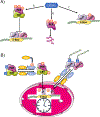Circadian Regulation of Cardiac Physiology: Rhythms That Keep the Heart Beating
- PMID: 31589825
- PMCID: PMC7012667
- DOI: 10.1146/annurev-physiol-020518-114349
Circadian Regulation of Cardiac Physiology: Rhythms That Keep the Heart Beating
Abstract
On Earth, all life is exposed to dramatic changes in the environment over the course of the day; consequently, organisms have evolved strategies to both adapt to and anticipate these 24-h oscillations. As a result, time of day is a major regulator of mammalian physiology and processes, including transcription, signaling, metabolism, and muscle contraction, all of which oscillate over the course of the day. In particular, the heart is subject to wide fluctuations in energetic demand throughout the day as a result of waking, physical activity, and food intake patterns. Daily rhythms in cardiovascular function ensure that increased delivery of oxygen, nutrients, and endocrine factors to organs during the active period and the removal of metabolic by-products are in balance. Failure to maintain these physiologic rhythms invariably has pathologic consequences. This review highlights rhythms that underpin cardiac physiology. More specifically, we summarize the key aspects of cardiac physiology that oscillate over the course of the day and discuss potential mechanisms that regulate these 24-h rhythms.
Keywords: chronobiology; heart; mitochondrial quality control; posttranslational modification; redox biology.
Figures



References
-
- Edery I 2000. Circadian rhythms in a nutshell. Physiol Genomics 3: 59–74 - PubMed
-
- Degaute JP, van de Borne P, Linkowski P, Van Cauter E. 1991. Quantitative analysis of the 24-hour blood pressure and heart rate patterns in young men. Hypertension 18: 199–210 - PubMed
-
- Martino TA, Young ME. 2015. Influence of the cardiomyocyte circadian clock on cardiac physiology and pathophysiology. J Biol Rhythms 30: 183–205 - PubMed
Publication types
MeSH terms
Grants and funding
LinkOut - more resources
Full Text Sources
Research Materials

